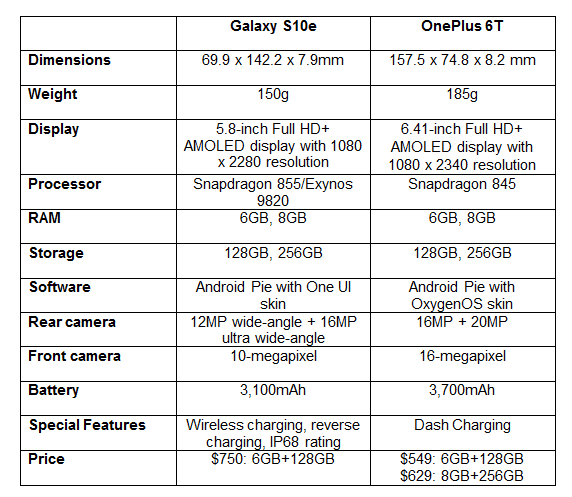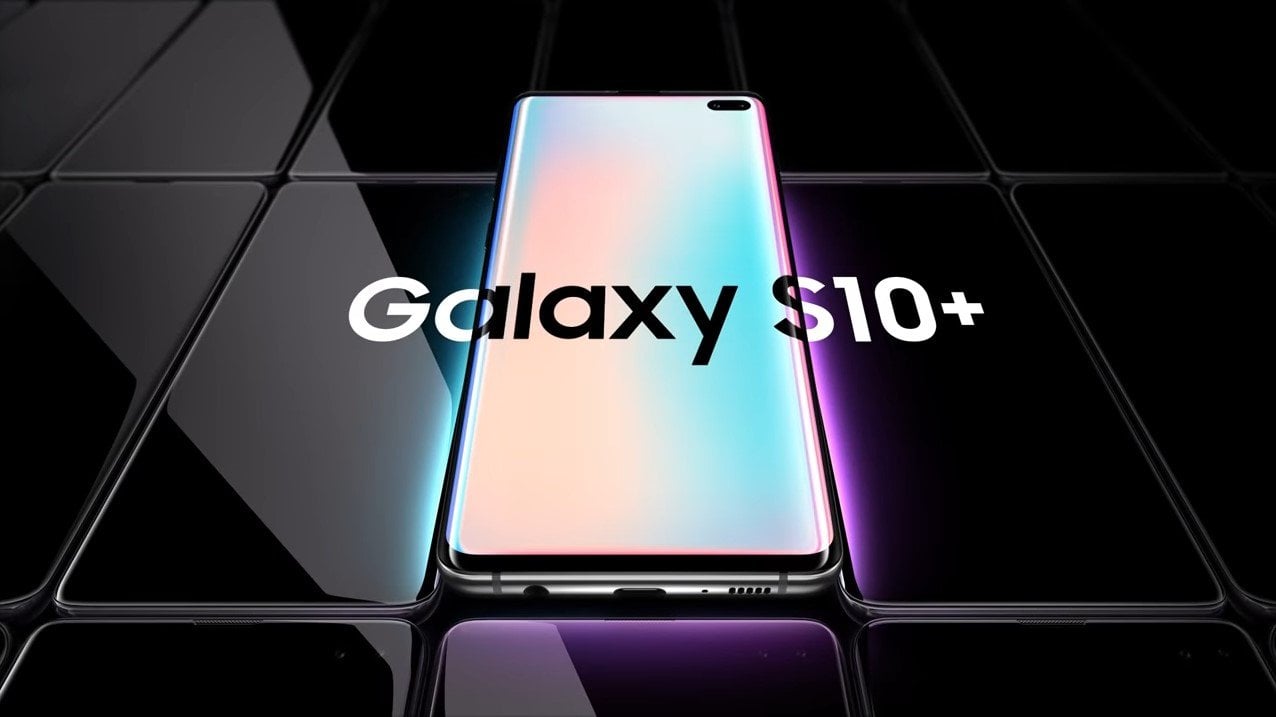Samsung launched a plethora of smartphones and wearable devices at its Unpacked event in San Francisco. The Galaxy Fold is a ridiculously expensive phone ($1980) that even most of the Samsung employees can’t afford. The Galaxy S10 and S10+ are the company’s high-end flagship models. For the first time, Samsung has launched an affordable version called Galaxy S10e to compete with the likes of OnePlus 6T. Let’s dive into a detailed Galaxy S10e vs OnePlus 6T comparison to see whether Samsung’s new affordable phone can take on the OnePlus 6T in terms of value for money.
Samsung has given Galaxy S10e the same treatment that Apple has given to its iPhone XR. It offers flagship-level performance at a relatively lower price, and lacks some of the luxury features of its more expensive siblings to justify its lower price. Only time will tell whether Galaxy S10e can disrupt the mid-to-high-end smartphone market, which is currently dominated by OnePlus in countries like China and India.
Galaxy S10e vs OnePlus 6T: Design
Samsung has overhauled the design of its flagship smartphones with the Galaxy S10 series. On the front, it has a nearly bezel-less Infinity-O display with a laser cut hole in the top right corner to accommodate the front camera. The rear panel is made out of the glass to facilitate wireless charging and the dual cameras are arranged horizontally.
The Galaxy S10e measures 69.9 x 142.2 x 7.9mm and weighs just 150g. Its all-glass body is supported by an aluminum frame in the middle. It comes in some cool color options such as Prism White, Prism Black, and Canary Yellow.
The OnePlus 6T is larger, thicker, and heavier than the S10e because it has a bigger display. It measures 157.5 x 74.8 x 8.2 mm and weighs 185g. It also has a glass rear panel with dual cameras. The OnePlus 6T also has an aluminum chassis. While the S10e uses a punch-hole display to accommodate the front camera, OnePlus 6T has a tiny waterdrop notch for the selfie camera.
Galaxy S10e vs OnePlus 6T: Display
The Galaxy S10e gets a 5.8-inch Dynamic AMOLED display with Full HD+ resolution and 19:9 aspect ratio. Unlike its more expensive siblings, the display is not curved on the edges. But it still has an impressive 83.3% screen-to-body ratio. It has a 522ppi pixel density. The screen is protected by Corning’s Gorilla Glass 5.
The OnePlus 6T features a bigger 6.41-inch Optic AMOLED display with a Full HD+ resolution of 1080 x 2,340 and a 19.5:9 aspect ratio. It has a 402ppi pixel density and a higher 85.6% screen-to-body ratio. The screen has a tiny waterdrop notch at the top to house the camera. Both the phones deliver vibrant colors, deep blacks, and bright whites. Both the screens offer an immersive visual experience.
Galaxy S10e vs OnePlus 6T: Processing power
The Galaxy S10e is not as expensive as the S10 and S10+, but it’s no slouch. It runs the same Snapdragon 855 (US market) or Exynos 9820 processor (rest of the world) as its more expensive siblings. The base model packs 6GB RAM and 128GB of storage while the more expensive option gets 8GB RAM and 256GB of storage. There is a microSD card slot with support for up to 512GB of external storage to ensure that you never run out of storage.
The OnePlus 6T runs last year’s Snapdragon 845 processor, but it’s powerful enough to take care of any task you can throw at it. It is available in 6GB and 8GB RAM variants with 128GB or 256GB of internal storage. There is also a McLaren edition with a staggering 10GB RAM, but that seems like overkill. Both the devices deliver blazing fast performance. You won’t experience any lag while multitasking or playing graphics intensive games.
Galaxy S10e vs OnePlus 6T: Camera
The Galaxy S10e gets dual cameras on the back. It has a 12-megapixel wide-angle lens with variable apertures of f/1.5 and f/2.4, and a 123-degree ultra-wide-angle 16MP lens with an f/2.2 aperture. It supports optical image stabilization and 4K video recording. On the front, it features a 10-megapixel lens with f/1.9 aperture, which is the same as the Galaxy S10 camera.
The OnePlus 6T also sports a dual camera system on the back. It consists of a primary 16MP sensor with an f/1.7 aperture and OIS. The second camera is a 20MP lens with an f/1.7 aperture. Just like Galaxy S10e, it can also record 4K videos. The OnePlus 6T has a 16MP camera on the front for selfies. Both Samsung and OnePlus have used software tricks on their smartphones to improve the photography experience, especially in low-light conditions.
Galaxy S10e vs OnePlus 6T: Battery
The Galaxy S10e packs a decent 3100mAh battery, which is smaller than 3400mAh inside Galaxy S10 and 4100mAh in the Galaxy S10+. The S10e has a smaller 5.8-inch display, so the battery should easily last a full day of normal usage. It supports fast charging as well as reverse charging, meaning you could use the S10e to charge other compatible devices.
In contrast, OnePlus 6T features a giant 3700mAh battery which lasts more than a day of normal usage. It supports the company’s proprietary Dash Charging technology for fast charging. Unfortunately, the OnePlus 6T doesn’t support wireless charging.
Galaxy S10e vs OnePlus 6T: Security
While the Galaxy S10 and S10+ get a blazing fast and highly secure ultrasonic fingerprint sensor embedded under the display, the Galaxy S10e features a regular capacitive fingerprint sensor placed on the side. The capacitive fingerprint sensor is fast and reliable, but it’s not as convenient as the in-display fingerprint reader.
The OnePlus 6T uses an optical fingerprint sensor placed under the display for authentication and security. Again, the optical sensor is not as secure as the ultrasonic technology used in the Galaxy S10 and S10+, but it’s more convenient than the capacitive fingerprint sensor on the S10e.
Galaxy S10e vs OnePlus 6T: Software
Both the Galaxy S10e and OnePlus 6T run the latest Android 9 Pie software, which brings a revamped interface, better notifications, and better energy efficiency. The S10e runs Samsung’s One UI skin on top of Android Pie. The One UI software makes interactions more intuitive as smartphone screens continue to get bigger. It displays navigation options near the bottom of the display to ensure they are within your thumb’s reach, while the content is displayed in the top half of the screen.
The OnePlus 6T gets the Chinese company’s custom OxygenOS interface, which has features like Smart Boost and Gaming Mode to deliver better performance while preserving the battery life. The OxygenOS also brings background optimization to keep the phones running fast even when they get older.
Galaxy S10e vs OnePlus 6T: Price
Samsung has made a few compromises to keep the Galaxy S10e’s costs down, but it couldn’t bring down the price in the same range as the OnePlus 6T. The S10e has been priced at $750 for the base model that offers 6GB RAM and 128GB storage. It is positioned to attract consumers looking to buy the iPhone XR or OnePlus 6T McLaren Edition.
The OnePlus 6T starts at $549 for the base model with 6GB RAM and 128GB storage. The 8GB RAM variant with 256GB storage is going to set you back by $649, which is much more affordable than the S10e.

The Galaxy S10e is backed by Samsung’s global presence and brand image. But in terms of value for money, the OnePlus 6T offers a better deal despite running an older processor. OnePlus is preparing to unveil its next-gen OnePlus 7 soon, which will be the S10e’s true competitor.





